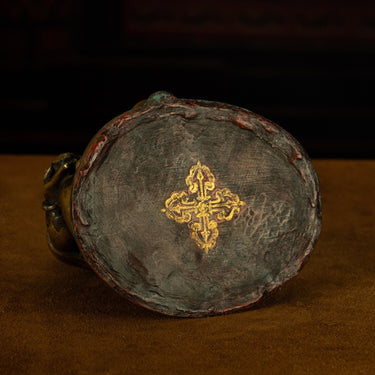13th Century Tibetan Antique Buddha Statue Yellow God of Wealth Turquoise Inlay Pala Style
Specs
13th-century Pala-style turquoise-inlaid Yellow Jambhala statue. The Pala style, popular in the 11th-12th centuries in Northeast India, influenced this Yellow Jambhala statue, likely crafted in Western Tibet. Combining local aesthetics, it formed a unique taste and style, also known as 'Tibetan Pala.' Among Pala-style statues, this one is relatively large. During this period, most Tibetan Pala statues were smaller, making examples of this size rare.
Yellow Jambhala, depicted with one face and two arms, has a plump face with delicate features, slightly tilted head, imparting a dynamic sense to the entire statue, seemingly bringing it to life. Adorned with a majestic crown and other exquisite ornaments, the deity's robust and dignified figure exudes a powerful aura. With a broad chest and prominent abdomen, the deity's ears are adorned with earrings, and the limbs are adorned with bracelets. The deity's right hand holds a jewel-spitting mongoose, symbolizing wealth, while the left hand clasps a treasure-spouting mongoose, signifying prosperity. Seated atop a lotus throne with a relaxed yet dynamic posture, the deity's right foot rests on a treasure vase, symbolizing wish-fulfilling abilities. The sturdy and low lotus throne firmly supports the entire statue.
Excellently preserved, the statue's diagonally draped sacred scarf is inlaid with turquoise, likely added in the post-Qing period. For discerning collectors, this statue is a valuable addition to any collection.
Product Details
Product information



Warranty Policy
At Kailash Energy, we are committed to providing high-quality jewelry and ensuring customer satisfaction. To offer you peace of mind with your purchase, we provide a 30-day warranty for our products under normal wear conditions.
Warranty Coverage
Our 30-day warranty covers quality-related issues under normal use, including but not limited to:
- Chain breakage
- Clasp damage
- Stone detachment
If you encounter any of these issues within 30 days of receiving your package, please contact our customer service team. We will assess the issue and provide a reasonable solution, such as repair, replacement, or other forms of assistance.Exclusions from WarrantyThis warranty does not cover:
- Damage due to improper use, accidents, or external force
- Wear and tear from prolonged usage
- Exposure to chemicals, water, or extreme conditions
- Unauthorized repairs or modifications
How to Claim Your Warranty
- Contact our customer service team within 30 days of receiving your package.
- Provide your order details and photos/videos of the issue.
- Our team will assess your case and guide you through the next steps.
Customer Support Contact Information
- Email: service@kailashenergy.com
- Customer Service Hours: Monday – Friday, 10:00 – 19:00 (Beijing Time, GMT+8)
For any questions regarding our warranty policy, please feel free to reach out to our customer support. We appreciate your trust in Kailash Energy and strive to provide the best service possible!
1. Can Kailash Energy ship to my country?
We ship to almost every country in the world except the following ones, due to shipping restrictions. We're sorry and will keep working on this.
- Philippines
- Indonesia
- Cuba
- Iran
- Sudan
- Syria
2. How much does shipping cost?
For items under $150, you will need to pay $18 for shipping.
PS. We have free shipping site-wide promotions during the sale season. Stay tuned!
3. How long will it take for my order to arrive?
Total delivery time = Processing time + Shipping time
(Not including customs delays, weekends, holidays, and any unforeseen circumstances)
Processing Time: 2-5 business days
Standard Shipping Time: 10-20 business days
For orders to South America and the Russian Federation, shipping may take more than 1 month due to transport and customs issues.
4. How may I track my order?
Once your order is shipped, we will send you an email with the corresponding information. After that, you will be able to track your order at https://kailashenergy.com/apps/track123.
PS. Please allow 1-2 business days for tracking information to be available.
5. What if the package doesn’t arrive?
If you don’t get your package 30 days after it was shipped, please contact us at: service@kailashenergy.com. We’ll either resent a new one to you or give you a full refund.
Shipping and Monitoring Processes
At Kailash Energy, we aim to offer you the best shipping and monitoring options. Every day, we deliver to hundreds of customers, ensuring that we provide the very highest levels of responsiveness to you within our business hours.
Second-stage logistics model
Your order will be shipped from Tibet to the monitoring center of Shanghai and the second stage of logistics will be shipped to you from Shanghai. In this process, our particular monitoring process will make sure that your package is well delivered and protected. After passing all the required quality checks, it will be shipped to your desired location as quickly as possible. You will receive 2 emails about these 2 stages of delivery.
About monitor center
Key points including packages, and main products will be carefully tested, making sure that you can receive our best products and delivery services. Specifically, professional, disposable, and nitrile powder-free gloves are expected to be used by professors for our quality inspection.
Facebook: @KailashEnergy
E-Mail: service@kailashenergy.com
Why Kailash Energy?
FREQUENTLY ASKED QUESTIONS
Are your gems from Mount Kailash?
Can I customize my Mount Kailash energy stone jewelry?
📩 Leave Your Email
Receive Sacred Updates
Discover the blessings and cosmic energy behind our spiritual jewelry.
Let your inner spirit resonate—starting now.
































